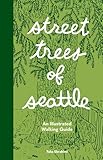When I first flipped through “Street Trees of Seattle”, I had the impression this was a graphic novel style treatment of a field guide. After a closer look, I realized my failure to appreciate the incredible amount of depth and details provided by the author and illustrator Taha Ebrahimi.
In one sense, this is a collection of neighborhood maps of Seattle indicating significant street trees. But it is also like a field guide, as each of the trees are identified with drawings and succinct descriptions of distinguishing characteristics. There is no wasted space; only the most significant features are included allowing a walker, with book in hand, to be certain of recognition.
 Throughout there are “deeper digs” that tell the highlights of specimen trees, or their neighborhood, or a snippet of Seattle history. For those who like facts, this is a gold mine. The author uses width as the primary measure of size as that proved the most reliable. Other nuggets include the earliest recorded date for a genus in Seattle, or the total number planted as street trees. The most numerous? Maples (Acer) with nearly 37,000, or 22% of the total.
Throughout there are “deeper digs” that tell the highlights of specimen trees, or their neighborhood, or a snippet of Seattle history. For those who like facts, this is a gold mine. The author uses width as the primary measure of size as that proved the most reliable. Other nuggets include the earliest recorded date for a genus in Seattle, or the total number planted as street trees. The most numerous? Maples (Acer) with nearly 37,000, or 22% of the total.
These facts come from the data published in 2020 by Seattle Department of Transportation which Ebrahimi, taking advantage of the lull in society during the height of the Covid pandemic, verified by walking these neighborhoods. This book does not provide an exhaustive inventory. Instead, the author concentrated on a single genus in each area, supplemented with a listing of other “notable” street trees. The impressive list of reference sources highlights the extent of the research.
Ultimately, Ebrahimi hopes all these drawings and facts are just a starting point to encourage readers to get out to walk and really look at their neighborhoods. Hopefully, this allows you to “make contact with the urban forest, to know the stories that came before us and to connect with a sense of place that data by itself can never capture.”
Reviewed by: Brian Thompson on August 19, 2024
Excerpted from the Fall 2024 issue of the Arboretum Bulletin